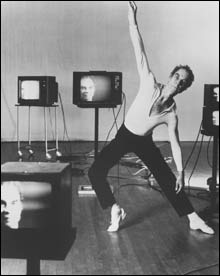
BIPED: was the first dance Merce Cunningham made using motion capture. |
NEW YORK — One persistent question surrounding the 35th Dance on Camera Festival, which winds up this Saturday at Lincoln Center’s Walter Reade Theater, is “Just what is dance film?” As a category it’s even more accommodating than dance itself. There were films of dances and films about dances. There were documentaries on historical and contemporary dance stars. There were experimental films of dancers and dancelike cinematic fantasies made by dancers. There were story films, real and imaginary, evocative shorts and longwinded tributes, and even a forgotten Hollywood spectacle, Gene Kelly’s 1956 Invitation to the Dance.The best of the 11 films I was able to see last week showcased contemporary choreographers in vastly different settings. Charles Atlas, a long-time collaborator of Merce Cunningham, filmed his 1999 dance Biped. One Flat Thing, Reproduced originated as a stage dance by William Forsythe (One Flat Thing) but reached the screen in a filmic interpretation by the Belgian director Thierry de Mey. And Lucinda Childs was the subject of a documentary by Patrick Bensard, director of the Cinémathèque de la Danse in Paris.
What I liked best about all three films was how they stuck to the subject. Although they all used camera work and editing to provide perspective, you came away from each with a real sense of having gotten closer to something you’d maybe suspected before but couldn’t have learned any other way.
Patrick Bensard was bowled over by Lucinda Childs’s dancing in Einstein on the Beach, the celebrated Robert Wilson/Philip Glass spectacle of the 1970s. He followed her career, which has largely unfolded in Europe since then, and around 2001 he began a series of interviews with her that form the kernel of this film. When she isn’t working abroad, Childs now lives on Martha’s Vineyard, having finally given up her loft in gentrified SoHo, and the tranquil seaside landscape seems to complement her reflections on her working process.
Lucinda Childs follows standard documentary practice: a composite of talking heads, archival performance clips, and scenes from recent rehearsals. Childs works with dancers from the Ballet de l’Opéra du Rhin on a reconstruction of her 1979 Dance and coaches Mikhail Baryshnikov in pieces she was setting for his White Oak Dance Project. These components are very skillfully put together so that you never feel the droning pall of Significance that muffles the usual fare on PBS or the History Channel. But the film doesn’t speed through its paces faster than the mind can process. So you get to savor the perceptive observations of collaborators like Glass, Wilson, and leader-of-the-’60s-dance-avant-garde Yvonne Rainer.
Childs projects her own star qualities, both in her thoughtful interviews and in clips of her dancing, where you see why she’s known as a paragon of transparent musicality and even-tempered determination. The same qualities permeated Ten Part Suite, the piece she made two years ago for Boston Ballet. Archival material reveals her zany side — her 1964 solo Carnation, a triumph of deadpan Dada involving kitchen sponges and hair curlers, and some droll footage where she plays a gum-chewing hairdresser who looks like Lucile Ball.